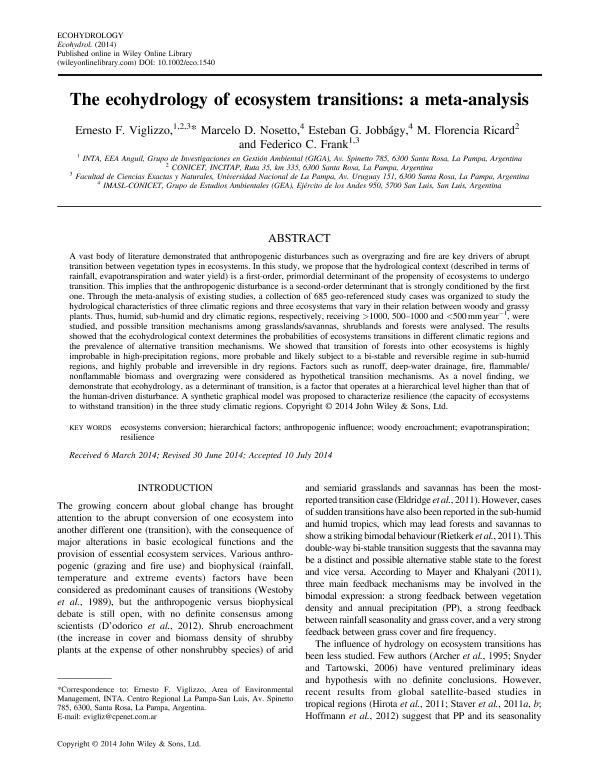Mostrar el registro sencillo del ítem
dc.contributor.author
Viglizzo, Ernesto Francisco

dc.contributor.author
Nosetto, Marcelo Daniel

dc.contributor.author
Jobbagy Gampel, Esteban Gabriel

dc.contributor.author
Ricard, Maria Florencia

dc.contributor.author
Frank, Federico C.
dc.date.available
2016-09-06T20:17:07Z
dc.date.issued
2014-06
dc.identifier.citation
Viglizzo, Ernesto Francisco; Nosetto, Marcelo Daniel; Jobbagy Gampel, Esteban Gabriel; Ricard, Maria Florencia; Frank, Federico C.; The ecohydrology of ecosystem transitions: a meta-analysis; Wiley; Ecohydrology; 8; 5; 6-2014; 911-921
dc.identifier.issn
1936-0584
dc.identifier.uri
http://hdl.handle.net/11336/7491
dc.description.abstract
A vast body of literature demonstrated that anthropogenic disturbances such as overgrazing and fire are key drivers of abrupt transition between vegetation types in ecosystems. In this study, we propose that the hydrological context (described in terms of rainfall, evapotranspiration and water yield) is a first-order, primordial determinant of the propensity of ecosystems to undergo transition. This implies that the anthropogenic disturbance is a second-order determinant that is strongly conditioned by the first one. Through the meta-analysis of existing studies, a collection of 685 geo-referenced study cases was organized to study the hydrological characteristics of three climatic regions and three ecosystems that vary in their relation between woody and grassy plants. Thus, humid, sub-humid and dry climatic regions, respectively, receiving >1000, 500?1000 and <500mmyear1, were studied, and possible transition mechanisms among grasslands/savannas, shrublands and forests were analysed. The results showed that the ecohydrological context determines the probabilities of ecosystems transitions in different climatic regions and the prevalence of alternative transition mechanisms. We showed that transition of forests into other ecosystems is highly improbable in high-precipitation regions, more probable and likely subject to a bi-stable and reversible regime in sub-humid regions, and highly probable and irreversible in dry regions. Factors such as runoff, deep-water drainage, fire, flammable/ nonflammable biomass and overgrazing were considered as hypothetical transition mechanisms. As a novel finding, we demonstrate that ecohydrology, as a determinant of transition, is a factor that operates at a hierarchical level higher than that of the human-driven disturbance. A synthetic graphical model was proposed to characterize resilience (the capacity of ecosystems to withstand transition) in the three study climatic regions. Copyright © 2014 John Wiley & Sons, Ltd.
dc.format
application/pdf
dc.language.iso
eng
dc.publisher
Wiley

dc.rights
info:eu-repo/semantics/openAccess
dc.rights.uri
https://creativecommons.org/licenses/by-nc-sa/2.5/ar/
dc.subject
Ecosystems Conversion
dc.subject
Hierarchical Factors
dc.subject
Anthropogenic Influence
dc.subject
Woody Encroachement
dc.subject
Evapotranspiration
dc.subject
Resilience
dc.subject.classification
Ciencias Medioambientales

dc.subject.classification
Ciencias de la Tierra y relacionadas con el Medio Ambiente

dc.subject.classification
CIENCIAS NATURALES Y EXACTAS

dc.title
The ecohydrology of ecosystem transitions: a meta-analysis
dc.type
info:eu-repo/semantics/article
dc.type
info:ar-repo/semantics/artículo
dc.type
info:eu-repo/semantics/publishedVersion
dc.date.updated
2016-05-16T20:08:42Z
dc.journal.volume
8
dc.journal.number
5
dc.journal.pagination
911-921
dc.journal.pais
Estados Unidos

dc.journal.ciudad
Hoboken
dc.description.fil
Fil: Viglizzo, Ernesto Francisco. Instituto Nacional de Tecnologãa Agropecuaria. Centro Regional la Pampa-san Luis. Estaciã³n Experimental Agropecuaria Anguil; Argentina. Consejo Nacional de Investigaciones Cientificas y Tecnicas. Instituto de Ciencias de la Tierra y Ambientales de la Pampa; Argentina. Universidad Nacional de La Pampa. Facultad de Ciencias Exactas y Naturales; Argentina
dc.description.fil
Fil: Nosetto, Marcelo Daniel. Consejo Nacional de Investigaciones Científicas y Técnicas. Centro Científico Tecnológico San Luis. Instituto de Matemática Aplicada de San Luis; Argentina
dc.description.fil
Fil: Jobbagy Gampel, Esteban Gabriel. Consejo Nacional de Investigaciones Científicas y Técnicas. Centro Científico Tecnológico San Luis. Instituto de Matemática Aplicada de San Luis; Argentina
dc.description.fil
Fil: Ricard, Maria Florencia. Consejo Nacional de Investigaciones Cientificas y Tecnicas. Instituto de Ciencias de la Tierra y Ambientales de la Pampa; Argentina
dc.description.fil
Fil: Frank, Federico C.. Instituto Nacional de Tecnologãa Agropecuaria. Centro Regional la Pampa-san Luis. Estaciã³n Experimental Agropecuaria Anguil; Argentina. Universidad Nacional de La Pampa. Facultad de Ciencias Exactas y Naturales; Argentina
dc.journal.title
Ecohydrology

dc.relation.alternativeid
info:eu-repo/semantics/altIdentifier/url/http://onlinelibrary.wiley.com/doi/10.1002/eco.1540/abstract
dc.relation.alternativeid
info:eu-repo/semantics/altIdentifier/doi/http://dx.doi.org/10.1002/eco.1540
Archivos asociados
